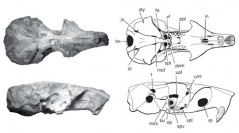

 Geodiversitas
30 (3) - Pages 593-609
Geodiversitas
30 (3) - Pages 593-609Two new genera and species of heteromyid rodents are described: Eochaetodipus asulcatus n. gen., n. sp. from the late Arikareean (earliest Miocene) of Nebraska and Mioperognathus willardi n. gen., n. sp. from the Barstovian (middle Miocene) of New Mexico. Eochaetodipus asulcatus n. gen., n. sp. is based on a nearly complete skull with associated mandibles and some postcranial material. This specimen is the earliest recognized member of the subfamily Perognathinae based on shared cranial and skeletal features with extant perognathines (mastoid inflation; reduction of incisive foramina; separation of the buccinator and masticatory foramina; more gracile skeleton). Eochaetodipus n. gen. is viewed as more primitive than other perognathines because it lacks a number of derived features of the latter. The cranium of Mioperognathus n. gen. was previously described as “Perognathus minutus”. It differs from that of Eochaetodipus in a number of features that are considered derived for perognathines (loss of the accessory foramen ovale; greater inflation of the bulla and mastoid; reduction of the squamosal dorsal to the external acoustic meatus to a thin bar; presence of an unossifed area on the orbital wall; grooved upper incisors), but is distinct from extant perognathines in several characters interpreted as primitive (presence of temporal foramen; less inflated bulla; longer temporalis scar). A phylogenetic analysis shows that the perognathine clade arose from a mioheteromyine-like ancestor separate from the Heteromyinae.
Mammalia, Rodentia, Heteromyidae, Perognathinae, cranial foramina, Barstovian, Arikareean, Miocene new genera, new species